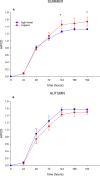Recover of Soil Microbial Community Functions in Beech and Turkey Oak Forests After Coppicing Interventions
- PMID: 38940921
- PMCID: PMC11213729
- DOI: 10.1007/s00248-024-02402-2
Recover of Soil Microbial Community Functions in Beech and Turkey Oak Forests After Coppicing Interventions
Abstract
Forest management influences the occurrence of tree species, the organic matter input to the soil decomposer system, and hence, it can alter soil microbial community and key ecosystem functions it performs. In this study, we compared the potential effect of different forest management, coppice and high forest, on soil microbial functional diversity, enzyme activities and chemical-physical soil properties in two forests, turkey oak and beech, during summer and autumn. We hypothesized that coppicing influences soil microbial functional diversity with an overall decrease. Contrary to our hypothesis, in summer, the functional diversity of soil microbial community was higher in both coppice forests, suggesting a resilience response of the microbial communities in the soil after tree cutting, which occurred 15-20 years ago. In beech forest under coppice management, a higher content of soil organic matter (but also of soil recalcitrant and stable organic carbon) compared to high forest can explain the higher soil microbial functional diversity and metabolic activity. In turkey oak forest, although differences in functional diversity of soil microbial community between management were observed, for the other investigated parameters, the differences were mainly linked to seasonality. The findings highlight that the soil organic matter preservation depends on the type of forest, but the soil microbial community was able to recover after about 15 years from coppice intervention in both forest ecosystems. Thus, the type of management implemented in these forest ecosystems, not negatively affecting soil organic matter pool, preserving microbial community and potentially soil ecological functions, is sustainable in a scenario of climate change.
Keywords: Coppice and high forest; Enzyme activities; Microbial functional diversity; Soil organic C.
© 2024. The Author(s).
Conflict of interest statement
The authors declare no competing interests.
Figures








References
-
- United Nations (2015) Transforming our world: the 2030 agenda for sustainable development. Available online: https://documents.un.org/doc/undoc/gen/n15/291/89/pdf/n1529189.pdf?token...
-
- Chirici G, Giannetti F, Mazza E, et al. Monitoring clearcutting and subsequent rapid recovery in Mediterranean coppice forests with Landsat time series. Ann For Sci. 2020;77:1–14. doi: 10.1007/s13595-020-00936-2. - DOI
-
- Mayer M, Prescott CE, Abaker WEA, et al. Forest ecology and management tamm review: influence of forest management activities on soil organic carbon stocks: a knowledge synthesis. For Ecol Manage. 2020;466:118127. doi: 10.1016/j.foreco.2020.118127. - DOI
-
- Persaud N, Dagher R (2021) The United Nations: 2030 Sustainable Development Goals Agenda. In: The role of monitoring and evaluation in the UN 2030 SDGs Agenda. Palgrave Macmillan
-
- Savill PS (2004) SILVICULTURE | Silvicultural systems. Encycl For Sci 1003–1011. 10.1016/b0-12-145160-7/00223-4
MeSH terms
Substances
LinkOut - more resources
Full Text Sources

